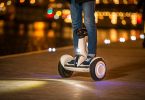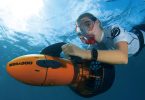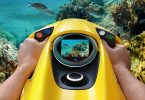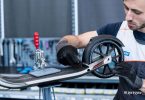My name is Phillip Gray and I love going outdoors riding on skates and scooters. I work as a graphic designer and I love creativity. This is why I appreciate the different creative scooter’s designs. I’ve been riding on kick scooters ever since I was 5 and one of my early scooters had grown-up together with me.
Why do you need an underwater scooter
An underwater scooter also called a DPV (for Diver Propulsion Vehicle) is a device already very popular with divers but also increasingly by “vacationers”, or “amateur” just for leisure.
A diving thruster is an immersive device equipped with a turbine or propeller propulsion system. The diver grabs the aircraft with handles and holds it in front of him. Propulsion allows the diver to be transported with unrivaled ease and agility.
Anyone trying for the first time a DPV to the true impression of being able to move like a fish, at speed and with the lightness of the aquatic world.
How does an underwater scooter work?
DPVs are powered by a rechargeable battery, leading to older generations, which have the distinction of being quite heavy but easy to maintain. The new generations want to be more futuristic with lithium-powered batteries. With these batteries, it’s more battery life, more power and therefore a higher price.
Underwater scooters are usually equipped with buttons on the sides to operate the engine. No braking on the other hand, just remove your hand from the buttons.
On the performance side, diving scooters can go up to 40 meters deep, reach top speeds between 4 and 20 kph and ensure a range of 30 to 90 minutes.
Want to be tempted by the experience of a DPV transport and discover a new way of understanding diving? Here are some tips to buy well
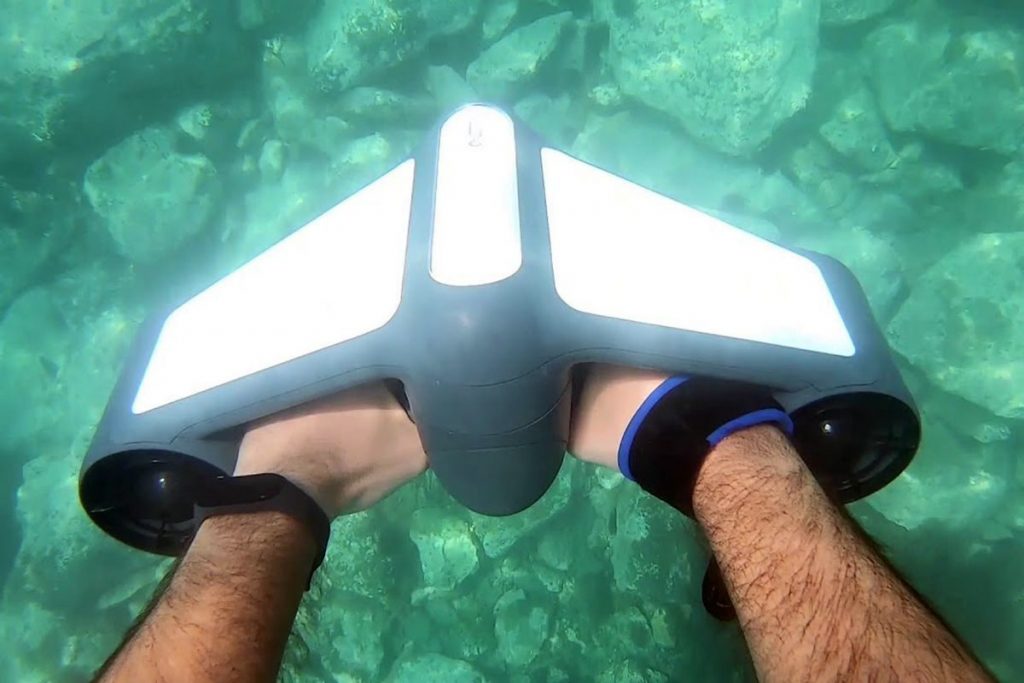
Why buy an underwater scooter?
For a new approach to diving
With a DPV the term “water ride” makes perfect sense. Traveling and discovering a wide area of seafloor landscapes can now be done in just a single dive.
For many years now, professionals have understood the advantages of using this means of transport, allowing them to move quickly to the desired spot.
In addition, it is now possible to leave the boat far enough away from a dive spot, thus allowing to achieve a discrete approach to a diving spot and not to frighten the seabed fauna.
To enjoy the sea in a different way
But underwater scooters are also fun recreational devices accessible to all, adults and children offering new opportunities to enjoy the sea.
You don’t need a wetsuit, an oxygen bottle, and more. A mask and a snorkel are enough to allow you to go and discover the seabed and have fun, by the beach, in a cove, or on the edge of a boat in the open sea.
To extend your diving range
One of the big advantages of the DPV is to be able to increase the range of an oxygen bottle for diving.
Indeed with this means of transport, the diver provides much less physical effort, and therefore, needs less oxygen during the dive. An oxygen bottle empties less quickly and thus significantly extends the range and therefore the duration of the dive.
Using a DPV during diving sessions involves no effort. All you have to do is hold on to your dive vehicle and let the thrusters pull you wherever you want. Like a fish in the water, you will move quickly without feeling any fatigue.
Getting around and saving energy
The DPV is a real means of transport, it will offer the same advantages as other means of transport, on water or on land: It allows you to move quickly with less effort.
It is also interesting to remember that water offers resistance to a mass in motion much higher than that of air. It is thus quite complicated to be fast on and underwater.
With a DPV, it is thus possible to move effortlessly at 5 or 6 kph for most models, which is a fast underwater speed.
To push the physical limits of apnea
The use of a DPV will completely transform the practice of apnea, allowing the diver to discover a new world that is inaccessible for 99% of snorkelers.
It is now possible to go much further, much faster, by consuming the same amount of oxygen as during static apnea.
Criteria for choosing an underwater scooter
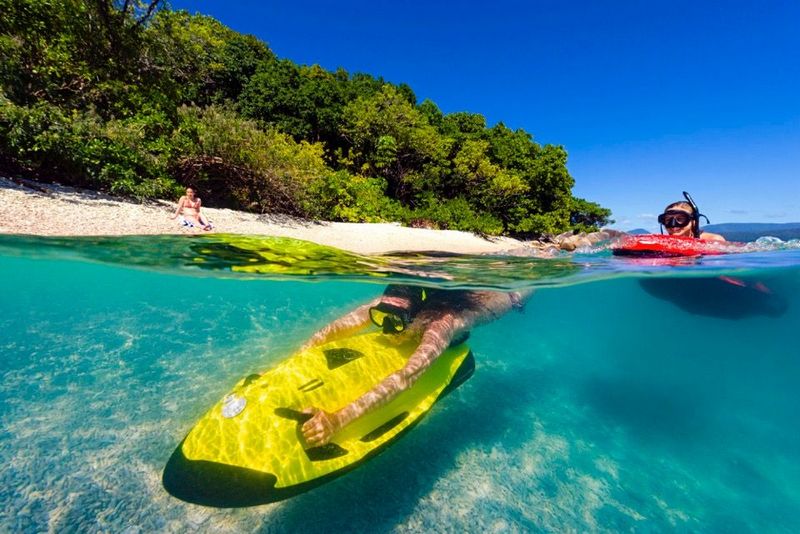
With the criteria below, you will be able to compare DPVs between them and get an idea of the best models suited to your wishes or practice.
Autonomy
Autonomy is a key criterion of choice for this type of product because once in the water, it becomes impossible to recharge the battery.
It is necessary to read the technical sheets of the manufacturers and check the type of battery that equips the device, its autonomy (if several engine modes exist, check the autonomy of each model), and finally the battery recharge time.
You should also know that your choice will be based on your use. If you are an amateur and your use of the device is only a few minutes, the battery life will not matter in this case.
On the other hand, for experienced divers wishing to immerse themselves in the seafloor world, a high-performance battery is essential. It would therefore be necessary to opt for a model with a battery life of more than 60 minutes.
Buoyancy
Buoyancy is a very important element when it comes to choosing your DPV. Indeed, buoyancy is a phenomenon that causes the object to flow deep in the ocean, remain at the same level, or float towards the surface.
One distinguishes, thus, three types of buoyancy, positive (this is the case where the object floats on the surface of the water), neutral (the case where the object constantly floats at the same level), and negative (the case where the object flows to the depths).
DPVs are exposed to this phenomenon and it is very important to learn about the chosen model.
The buoyancy of the object also varies depending on the type of water in which you will use it.
Speed
If you choose to use a DPV you may want to move around in the water faster. Thus, the reflection around the speed of the latter takes on its full meaning.
To increase the sensations tenfold, opt for a powerful model that offers good top speed. The latter will be expressed (in meters per second, km/h, or mp/h).
On some models, there are several modes of speed (fast mode, economical mode).
It should also be noted that speed and autonomy are intimately linked. The battery runs out quickly when you reach maximum speeds.
The depth of action
DPVs are recommended for a certain depth of action. Overstepped, your scooter could get damaged due to high water pressure.
If your need is limited to swimming pool use, a depth of action of 10 meters is more than sufficient. On the other hand, you should have a product up to 30 to 40 meters deep if you want to explore the seabed.

